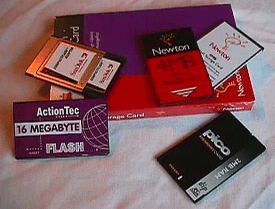
Memory Cards
As you may have noticed, I have been more than just somewhat puzzled in this column by the perplexing variety of memory cards available for PDAs. In the Newton range alone, there have been three different versions of PCMCIA (now called PC Card) memory cards supported, not all on the same Newton version, and these don't include card versions that work in Psion or Windows CE devices. This compatibility problem isn't indicated anywhere that I have every found on the card packaging, unless you buy expensive own brand PC Cards, and, as I pointed out in last month's column, in one case the suppliers own web pages gave incorrect compatibility recommendations (which has since been fixed).
Memory card nightmare

Of the PDAs I have covered so far, the Psion S5 uses Compact Flash cards (which can be fitted into a PC Card adaptor), and Newtons, eMates and Windows CE HPCs all can use PC Card memory. In fact, one device, the REX, itself is a memory PC Card. Of the common PDAs, only the PalmPilot and Nokia 9000 don't use PC Cards. When they first came out, I can remember spending around 300 GBP on a 2 Mb RAM card for my original Newton MessagePad (in 1993), then spending almost exactly the same amount for a 16 Mb Flash card in January 1997. Most recently I bought a 8 Mb Compact Flash card for the Psion Series 5, less than a year ago, for about 150 GBP. The current top of the range cards that are commonly available are 32 Mb, in either PC Card flash format, or Compact Flash.
Manufacturers and vendors web pages go extensively into the technical details. I can recommend the pages on PC Card memory at:
Newton information: http://userwww.service.emory.edu/~mdillah/PDAPage compatability chart: http://www.pdapage.com/Compatibility.htm
ALIX FAQ: http://www.alix.com/faq.htm
Compact Flash: http://www.sandisk.com/products/compactflash_specs.htm
PCMCIA FAQ: http://www.pc-card.com/pc_card_faq.html
If you believe the packaging, the only significant differences in memory cards are whether they are Flash, or SRAM (Static RAM). Flash cards consume more battery power to access (write access much more so that read access) and are correspondingly slower, but don't need a battery swap every six months to a year. If you keep the card for any length of time, or attempt to use it to archive infrequently used data, this makes a big difference to the convenience of use. The current SRAM cards are rarely seen, as they are far more expensive than flash memory (a factor of about x 4). These SRAM cards should work in most devices, unlike flash. Flash cards have a limited life, but as this is 100,000+ read/write cycles, I don't think anyone need worry about wearing out any flash cards soon.
There are different types of flash cards available. Some cards are in what is known as Intel or Linear format, which can optionally have attribute memory, which describes the layout of the card in something called the CIS (Card Information Structure). Older cards (Intel 1.0) don't have attribute memory, and can't be used in any Newton. None of these work with Windows CE.
Older flash cards required higher voltages for writing. These used 12V to write or erase, and 5V to read. Newer cards use 5V for all access. This is the first and biggest different between cards, and obviously requires different hardware support from PDAs that use them. For example, the eMate can only use 5V cards, whereas the Newton MessagePad 2000 can use both 5V and 12/5V cards. Older MessagePads with NewtOS 1.x can't use the 5V only cards. Given that none of this is usually mentioned on the PC Card packaging when you are trying to choose a card to buy, you can see why it might be confusing. But it gets worse...
Other cards use ATA format. This uses a version of the IDE disk interface to connect to the PDA, and effectively have their own file system structure built in to them, which is why you can read the directory of a Psion Series 5 CF card in a Windows CE HPC. Newton's can't use this type of card at all, but it is the commonest type available for Windows CE machines and Psions.
PC Cards also come in different sizes, called Type I, II and III; all memory cards that I have seen are Type II, and all the slots in PDAs I have seen are for Type II devices, so this shouldn't be an issue. Generally speaking, 5/12V cards are the cheapest of them all, followed (in order) by 5/5V cards, ATA cards and CF cards, with SRAM cards a long way in the rear.
All of the above cards come in PC Card format. Some digital cameras, and the Psion Series 5, use a sort of compatible, but much smaller, physical format known as Compact Flash. All CF cards are ATA type, but are slightly bigger than the average male big toe nail. This is great if you have a PDA with a CF slot, like the Psion Series 5 or the HP620LX; but also good for PDAs with PC Card slots, as most CF cards come with a passive carrier that holds the CF card, and fits neatly into a Type II PC Card slot.
My recommendation in a nutshell: if you have Windows CE, buy ATA flash cards; if you have a current Newton, buy 5V Linear flash, and don't expect to be able to use any type of card in a different PDA from the one it was bought for.
Words and design by:
Paul Lynch
Last updated: March 11, 1998